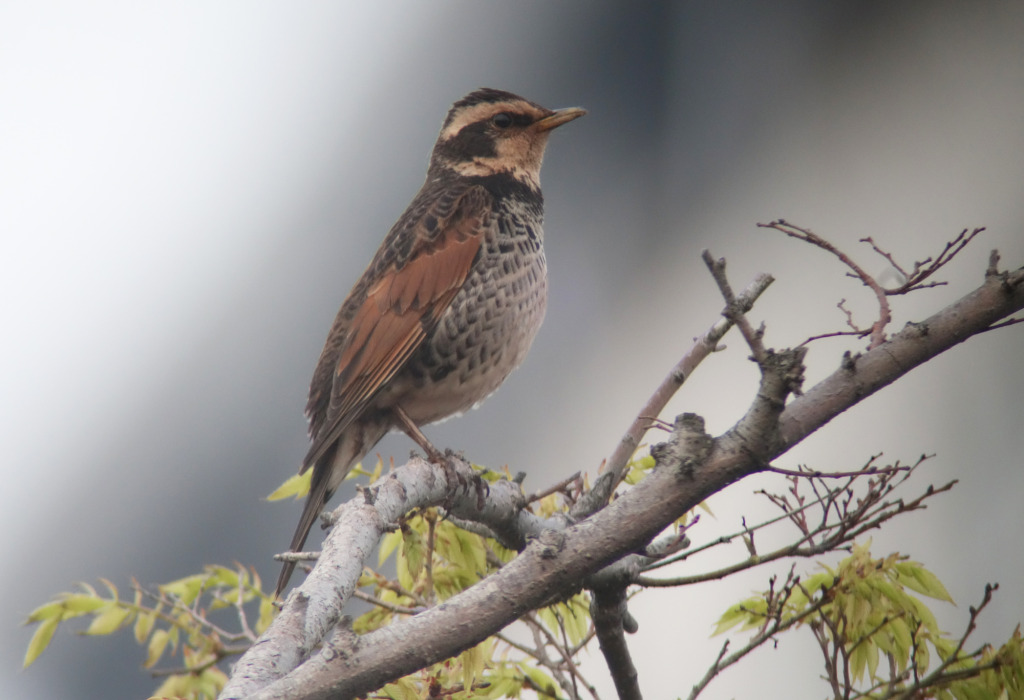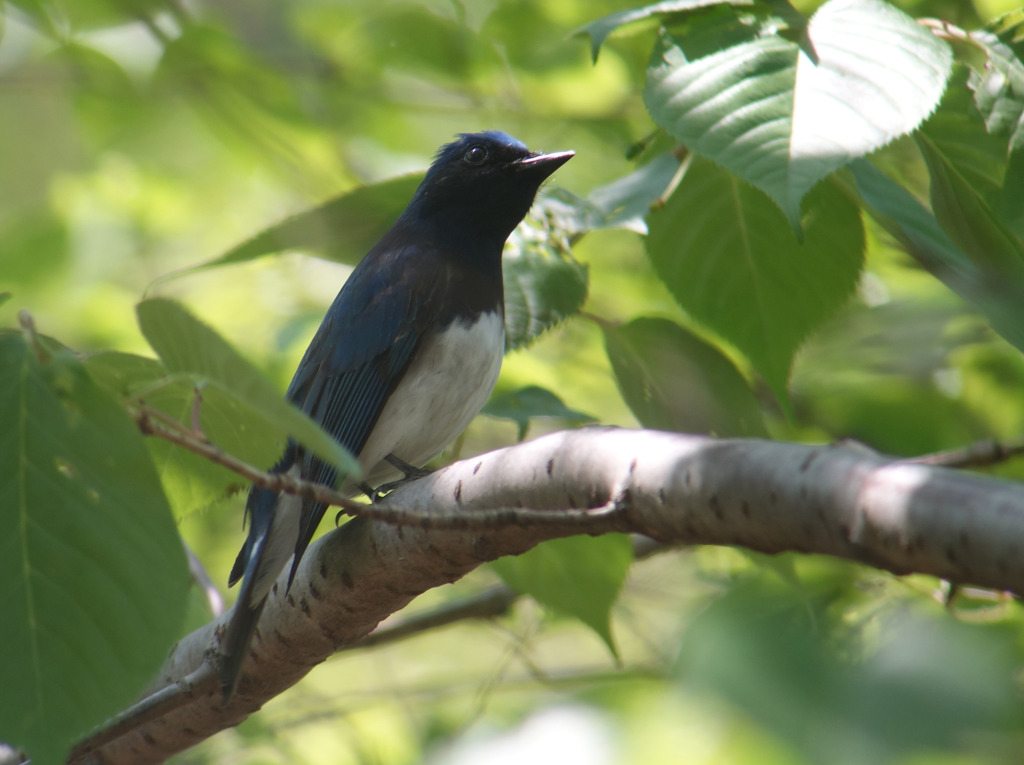Bird News from Nial Moores
Four days were spent (April 14th, 16th, 20th and 21st) with the aim of assessing turnover of migrants through this mainland site. Of greatest note was a small arrival of Sakhalin Leaf Warbler on 20th and 21st (with a national high day count of 5+ on both dates).
On 14th, weather was fair with southwesterly winds after 5-6 days of persistent north-easterlies; on 16th, light winds, and starting thinly overcast with rain showers by evening; on 20th, rain all day (following rain all day on 19th, with light, occasionally moderate, easterly winds veering southwest and southerly for a time then backing northeast again); and on 21st, largely clear with light south-westerlies. The rain on 19th and 20th was from a slow-moving low pressure system that passed more or less through the Korean Strait, displacing several Japan-bound migrants.
In addition to large numbers of Vinous-throated Parrotbill (probably 300+ throughout this period still), single Pacific Reef Egret on a couple of dates and 2-4 Black Kites daily, species of note included:
- Streaked Shearwater Calonectris leucomelas. Two on 20th.
- Western Osprey Pandion haliaetus. One on 16th.
- Grey-faced Buzzard Butastur indicus. One on 21st.
- Oriental Cuckoo Cuculus optatus. One on 21st.
- Oriental Scops Owl Otus sunia. One on 14th; three on 16th; and one on 20th.
- Common Kingfisher Alcedo atthis. One on 16th is the personal first record of this species at Igidae.
- Ashy Minivet Pericrocotus divaricatus. After one on 7th, four on 14th; nine on 20th; and nine on 21st.
- Japanese Waxwing Bombycilla japonica. After five on 10th, 20+ on 14th; 17 on 16th; 65 on 20th; and 20 on 21st.
- Korean Bush Warbler Horornis borealis. After the first heard on 3rd, none on 14th; four on 16th; one on 20th; and one on 21st.
- Asian Stubtail Urosphena squameiceps. Four on 14th; 21 on 16th; eight on 20th; and 17 on 21st.
- Pallas’s Leaf Warbler Phylloscopus proregulus. One (probable) was heard on 16th.
- Yellow-browed Warbler Phylloscopus inornatus. Usually fairly scarce in Busan. None on 14th; four on 16th; four on 20th; and seven on 21st.
- Pale-legged Leaf Warbler Phylloscopus tenellipes. The following are counts of birds heard singing: None on 14th; 5+ on 16th; two on 20th; and four on 21st. A further five or so birds were heard calling on 20th and 21st, some of which were suspected to be this species.
- Sakhalin Leaf Warbler Phylloscopus borealoides. The following are counts of birds heard singing: One on 16th, five on 20th, and five on 21st. Three of the birds on 21st were in an area not covered on the 20th. This appears to be a national high day-count. Two or more birds heard calling (but not singing) were also suspected to be this species on both 20th and 21st. Busan seems to be fairly reliable for this species during this period, being recorded here too on April 17th and / or 18th 2013 and 2014.
- Eastern Crowned Warbler Phylloscopus coronatus. The personal first of the year was one here on April 7th. Five on 14th; 19 on 16th; six on 20th; and 13 on 21st.
- White’s Thrush Zoothera aurea. Three on 16th; one on 20th; and one on 21st.
- Grey-backed Thrush Turdus hortulorum. One possible on 14th; 27 on 16th; five on 20th; and four on 21st. This species is usually fairly scarce in Busan (and rare in Japan). The surprisingly high peak on the 16th presumably was comprised largely of Korean-breeders, as this species peaked in number on Eocheong on April 26th (2011) and Socheong on April 29th (2010), with these later peaks perhaps associated with birds breeding towards the north of its range.
- Grey Thrush Turdus cardis. Six on 14th, two on 16th; one on 20th and 2+ on 21st.
- Pale Thrush Turdus pallidus. Twenty on 14th, rising to 151 on 16th and falling back to 78 on the 20th and 81 on the 21st.
- Brown-headed Thrush Turdus chrysolaus. One female on 16th was the only one seen well enough to confirm; several others heard on 16th and 20th were likely of this species.
- Dusky Thrush Turdus eunomus. Four on the 16th and one on 20th (this species is seldom recorded at this site).
- Asian Brown Flycatcher Muscicapa latirostris. Four on 16th were the only ones found.
- Blue-and-white Flycatcher Cyanoptila cyanomelana. None on 14th; four on 16th; 15 on 20th; and 19 on 21st. All of the males were of the nominate subspecies (which breeds in Japan), apart from two intermedia (which breeds on the Asian mainland including Korea) on 21st. One or two females were very warm-toned; others colder-grey; and at least two birds (see below) that initially looked female-like showed asymmetric male-blue patches and are therefore presumed to be Second Calendar-year males.
- Siberian Blue Robin Larvivora cyane. One or two on 16th (including a well-seen adult male); and two in song on 20th.
- Japanese Robin Larvivora akahige. One was heard in song on 14th; a female was seen well on 16th; and one probable was glimpsed briefly in the rain on 20th.
- Siberian Rubythroat Calliope calliope. One male on 14th was the only record.
- Red-flanked Bluetail Tarsiger cyanurus. One on 14th; 38 on 16th; five on 20th; and four on 21st. In 2010, the peak count of this species on Socheong Island in far northwestern ROK was on April 17th.
- Narcissus Flycatcher Ficedula narcissina. Two males on the 14th were the personal first of the year; rising to six on 16th; eleven on 20th (including two females); and falling back to eight on 21st (all males), with several in song.
- Stejneger’s Stonechat Saxicola stejnegeri. None on 14th; six on 16th; three on 20th; and one on 21st.
- Red-throated Pipit Anthus cervinus. This species appears to be rather scarce in Busan. One on 14th was a first personal record of this species in Igidae, with a second on 20th.
- Red Crossbill Loxia curvirostra. One on 16th.
- Eurasian Siskin Spinus spinus. Although there were at least 280 here on April 7th, numbers were much lower during the week under review with c.10 on 14th; 55 on 16th; 30 on 20th; and 11 on 21st.
- Tristram’s Bunting Emberiza tristrami. None on 14th; 12 on 16th; ten on 20th; and probably six on 21st.
All images below were digiscoped using a superb Swaorvski ‘scope.
 Black Kite Milvus migrans © Nial Moores
Black Kite Milvus migrans © Nial Moores
 Japanese Waxwing Bombycilla japonica © Nial Moores
Japanese Waxwing Bombycilla japonica © Nial Moores
 Dusky Thrush Turdus eunomus © Nial Moores
Dusky Thrush Turdus eunomus © Nial Moores
 Red-flanked Bluetail Tarsiger cyanurus © Nial Moores
Red-flanked Bluetail Tarsiger cyanurus © Nial Moores
 Blue-and-white Flycatcher Cyanoptila cyanomelana © Nial Moores (Adult male, top; two Second Calendar-year males;
Blue-and-white Flycatcher Cyanoptila cyanomelana © Nial Moores (Adult male, top; two Second Calendar-year males;
and female, lowest image)







